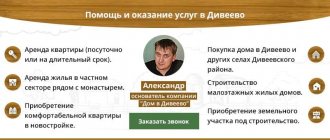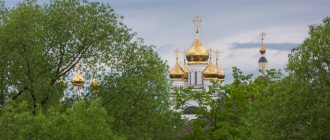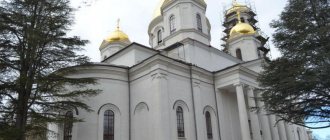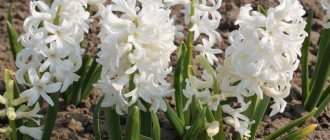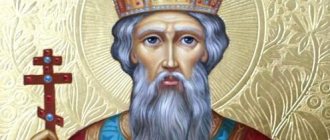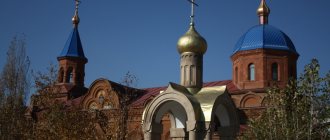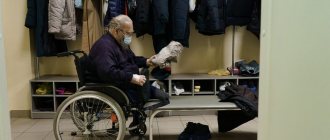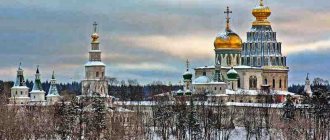Murom is one of the oldest Russian cities, famous for its Orthodox monasteries. Many pilgrims come to this picturesque place to touch the shrines. Murom is located in the Vladimir region, on the Oka River. This provincial town is over 1000 years old
Monument to Ilya Muromets
Murom received its name from the Finnish-Ugric tribe Muroma, which most likely means “people on land”. The first written mention of Murom is in the Tale of Bygone Years, but archaeological excavations indicate that the Murom lands were inhabited much earlier than 862, and on the territory of modern Murom in the 6th-7th centuries the so-called Nikolo-Naberezhnoe settlement with a military shelter was located - The Kremlin on Kremlin Hill.
Today the population of Murom is relatively small - 150 thousand inhabitants,
but at the same time there are four monasteries here:
- Spaso-Preobrazhensky Monastery,
- Holy Trinity Convent,
- Annunciation Monastery,
- Holy Resurrection Convent.
Visitors are amazed by the excellent condition of the restored monasteries of Murom and the well-groomed surrounding area (despite the large flow of tourists and pilgrims). You can enter all monasteries and even take photographs.
Trinity Convent in Murom Pilgrims come to the Trinity Monastery to venerate the relics of the holy faithful Prince Peter and Princess Fevronia - the patrons of the Orthodox family, love and prosperity in marriage. Saints Peter and Fevronia of Murom are an example of marital fidelity, devotion and love, which they preserved throughout their lives, overcoming all trials and temptations.
Peter and Fevronia of Murom For a long time, Murom was the extreme eastern outpost of Rus', located at the crossroads of trade routes between Russia and Bulgaria. Over time, the city of Murom acquired great importance as a trade center and from 1054 became the possession of the Chernigov princes, who turned Murom into the center of the Murom-Ryazan principality.
1. View of the Kazan Gate Church and bell tower. 2. Fragment of the bell tower of the Kazan Gate Church In 1392, the son of Dmitry Donskoy, Vasily I, annexed the Murom principality to the Moscow principality along with Nizhny Novgorod, Vologda, Meshchera, Tarusa. Murom squads fought on the Kulikovo Field, besieged Kazan, and participated in the liberation of Moscow from the Poles. Ivan the Terrible and Peter I visited Murom, A.S. Pushkin and A.S. Griboyedov, A.N. Radishchev and N.A. Nekrasov, I.A. Krylov and R.G. Derzhavin came. N.O. Hannibal, the mother of the great Russian poet A.S. Pushkin, was born on Murom soil.
Holy Trinity Convent
Ilya Muromets
The most famous native of the Murom land is the epic hero Ilya Muromets, repeatedly mentioned in folklore not only of Russians, but also of neighboring peoples. The apparent contradiction of the previous sentence is deceptive. Many researchers consider Ilya Muromets to be a real historical character. And the collective story of his life is simply amazing. Everyone has heard about the hero’s exploits for the glory of the Russian land. But some details of his biography are not so well known.
The grandfather of Ilya Muromets was a convinced pagan. Once, in a fit of anger, he chopped up a Christian icon with an ax. The punishment fell on his grandson: Ilya could not walk since childhood, and all attempts to heal him were unsuccessful. The boy could only train his arms: his legs rested lifelessly on the stove. This continued until the age of 33 (the age of Christ!). Two “kalik passersby” (wandering beggars) entered his house and asked him to give them “intoxicating beer.” Ilya took their request as a mockery and said so. But the strange Kaliki were not embarrassed and repeated the request, which sounded more like an order.
Ilya, unexpectedly for himself... stood up and fulfilled the request. But the Kaliki did not drink, but ordered Ilya to do so, who after this felt great strength within himself. This can't happen? I agree, with only one addition: if we consider only the visible physical world to really exist. After all, the “Kalikas” who visited Ilya were...Christ with one of his apostles (as it was written in the pre-revolutionary editions of the epic about Ilya Muromets).
At the end of his life, Ilya Muromets decided to devote himself to God. He became a monk of the Kiev-Pechersk Monastery under the name of Elijah of the Pechersk. His relics rest in the Near Caves of the Lavra. Their study, conducted in 1988 by a commission of the Ministry of Health of Ukraine, gave results confirming the epic descriptions.
The relics belonged to a very physically strong man, approximately 50 years old, 1m 77 cm tall (in the 12th century, the average male height did not exceed 165 cm). He did suffer from polio in his youth, and his bones showed signs of many battles and blows with swords and spears, broken ribs and broken collarbones. Researchers named the cause of death as a blow to the chest from a sword or spear. It is assumed that this happened during the capture of Kyiv by Prince Rurik, when the Pechora Lavra was destroyed by the Polovtsians who were part of the prince’s army. In 1643, the Monk Ilya Muromets became a saint of the Russian Orthodox Church.
Village Karacharovo
The former village of Karacharovo is now a microdistrict of Murom. Its main attraction is house number 279 on the street. Priokskaya, where the hero was born and lived. Those living here today have no doubt that they are his direct descendants. Nearby is the Trinity Church, founded by the hero himself. The dilapidated building is now being restored, its bell tower with the chapel of Ilya Muromets has been restored.
Trinity Church
A nearby holy spring with a bath began to flow from the blow of the hooves of Ilya’s mighty horse.
Holy spring with bath
Model Christian Family
The union of this holy couple became a true example of Christian marriage, and they became its patrons. People received this holiday with great response in their hearts.
The death of the saints occurred on June 25 according to the Gregorian calendar, 1228 (July 8 according to the Julian calendar). At the end of their lives, Saints Peter and Fevronya took monasticism and died on the same day. They bequeathed to put them in one coffin, but the brethren considered that this was against their rules, and therefore they were supposed to be buried in different graves, but somehow miraculously they ended up in one coffin, which they had prepared in advance. Believers perceived this fact as a great miracle. In 1547, the relics of the saints were canonized and are now kept in the convent of the city of Murom.
Annunciation Monastery Murom
Initially in the 12th century. on this site there was a wooden temple in which the spreaders of Christianity in Murom, princes Konstantin, Mikhail and Fedor, were buried. In honor of the capture of Kazan in 1553, Tsar Ivan the Terrible founded the Annunciation Monastery and the cathedral of the same name. The latter underwent a thorough reconstruction in the middle of the 17th century. The walls and baths of the monastery were also renewed in 1811. During the Patriotic War of 1812, the icons of the Iverskaya and Vladimir Mother of God were hidden in the monastery.
Annunciation Monastery Murom
Unlike many other churches, the closure of the monastery in 1919 can be considered conditional: the monks who moved to the city continued to serve there, and the relics of the saints were moved to local museums. During Soviet times, the Annunciation Cathedral in Murom was the only one functioning. The best 6-tier baroque iconostasis that has survived to this day also preserves icons from the 16th century. The entire monastery became fully operational again in 1991.
The icon of St. Elijah of Murom with a fragment of his relics is kept in the monastery, which was returned to believers in post-Soviet times and is still functioning.
Address - st. Krasnoarmeyskaya (formerly Uspenskaya), 16.
Troparion and kontakion to the holy princes Constantine, Michael and Theodore of Murom
Troparion, tone 4.
Constantine today cheerfully rejoices, standing before the throne of the Holy Trinity, seeing his fatherland, shining with spiritual masque, and Michael and Theodore, his sons, followed him, and they all pray together for our souls.
Kontakion, tone 8.
To the distinguished governor and faithful prince Constantine and your son, your fatherland, boasting, cries out, having you as a leader and protector, as having delivered you from the charms and filth of idols. For this reason, we cry out to you: Rejoice, most blessed Prince Constantine.
Spaso-Preobrazhensky Monastery Murom
This monastery is one of the oldest and most famous in Rus'. According to documentary evidence, at the end of the 11th century. the son of Vladimir Monomakh was buried in it. The monastery arose around the estates of the first Murom prince Gleb. The initially wooden monastery was destroyed and burned by the Tatar-Mongols.
In the middle of the 14th century. the monastery was restored in stone. Two centuries later, the Transfiguration Cathedral was built nearby. Since then it has not undergone significant changes. During sieges, the cathedral assumed the functions of a fortress. Its facade is characterized by some severity, and its interior – asceticism.
Spaso-Preobrazhensky Monastery Murom
Another feature of the facade is the helmet-shaped (and not onion-shaped, as usual) domes. Subsequently, the monastery complex was replenished with the Church of the Intercession of the Virgin Mary with five chapels, a bell tower, a rectory, a religious school and outbuildings. Prince Peter, who accepted the schema, lived here, as is recalled by the bas-relief where he is depicted together with Fevronia, and the icon with scenes from their Life.
In 1918, the monks were accused of helping the White Guards, and the monastery was closed. Part of the monastery property became an exposition of the city museum. The premises of the monastery housed a factory, then a military unit.
In the 90s, the monastery was returned to believers. Now here, at the address st. Lakina, 1, there is a functioning monastery. In 2006, it was replenished with the image of Ilya of Muromets, made by a local carver according to the parameters obtained from studying the relics of Ilya of Pechersk.
Peter
Paul called brother Peter to him and told him all his thoughts. Peter immediately realized that it was he who would have to meet with the accursed serpent. But he did not know where to get the Agrikov sword. One day in church, a young boy told Peter the location of this magic sword. Armed with the treasured sword, Peter went to his brother’s chambers and saw through the snake, which appeared before him in the form of his brother. It was not without God's help that Peter killed the serpent. However, after this meeting, the valiant warrior was covered with terrible ulcers, since the accursed creature doused him with a poisonous liquid before his death.
Holy Trinity Monastery Murom
This convent on the site of a wooden church was built in the mid-17th century. financed by a local wealthy merchant. Its ensemble includes the five-domed Trinity Cathedral and the Kazan Gate Church with a bell tower.
Their interiors are decorated with tiles with images of herbs, birds and animals. The church and bell tower were erected on a single foundation. The slits of the facade and the lace decor give them lightness and airiness. The frames of many icons are decorated with skillful embroidery by gold-embroidery nuns.
Holy Trinity Monastery Murom
The monastery is primarily known as the burial place of the married couple of the Murom princes Peter and Fevronia, a monument to whom is installed in front of the entrance. Fevronia lived here after her monastic tonsure.
In worldly life, the princely married couple Peter and Fevronia won the love of their subjects with their righteous lives. They refused to help anyone, suppressed anger and cruelty, did not strive for worldly wealth, and glorified the name of God.
Peter and Fevronia, who naturally became monks in their old age, prayed daily to die at the same time and be buried in the same coffin with a thin partition. This was made during their lifetime. After Peter and Fevronia actually died on the same day and hour, their bodies were nevertheless placed in separate coffins in different monasteries, considering joint burial to be contrary to monastic traditions.
However, the next morning it turned out that the separate coffins were empty, and the bodies of Peter and Fevronia were reunited in the common coffin they had prepared. The next attempt to separate them after death was again unsuccessful. The people reconciled themselves to the will of God, and the couple were buried in the Nativity of the Mother of God Cathedral of the monastery. During the Soviet years it was closed, and the remains of the princes were transferred to the local museum. But the monastery was protected as an architectural monument. Since 1993, the relics returned to the church have been kept in the Trinity Cathedral.
Monument to Peter and Fevronia of Murom
The memory of the blessed princes Peter and Fevronia is celebrated annually on July 8. Since 2008, this date has been considered the Day of Family, Love and Fidelity. Wedding processions of newlyweds come to the monument to Peter and Fevronia every day in the hope that their marriage will be just as strong.
Since 1975, on the territory of the monastery there has been a wooden church of St. Sergius of Radonezh, transported from a nearby village, an architectural monument of the 18th century. It operates only in the summer. Since 2001, the Nadezhda boarding house has been opened at the monastery for minor girls and the elderly. The current address of the monastery is Peasant Square, 3 A.
To holy places. Murom diocese. Part 1
The ideal of family holiness is marriage and righteous worldly life. Among the saints of God who labored on the Murom land are many families. Blessed Prince Peter and Princess Fevronia, righteous Juliania Lazarevskaya, who had a beloved husband and ten children; the blessed Prince Konstantin with his sons Mikhail and Theodore and his wife Irina... Together with the viewers of the program we will visit holy places associated with the ascetics of faith and love. “The Union of Love – a Wise Marriage” is the name of the monument located in front of the registry office in Murom.
This city seems to be completely saturated with love. Thousands of pilgrims come every year to worship the holy Murom wonderworkers with the hope of a happy marriage, strong love, and healthy children; they come to pray at their icons and holy relics, to ask for themselves, for their loved ones and their family. Vladimir Yakovlevich Chernyshev, Candidate of Historical Sciences:
– Saints Peter and Fevronia lived in the city of Murom in the 13th century. According to life, we know that Prince Pavel ruled in the city of Murom. It was to his princely family that the tempter of the human race, that is, the devil, Satan, flew, taking the form of a serpent or dragon. At the meeting, the city elders told the prince that the death of this serpent would come from Peter’s shoulder and from Agrikov’s sword.
The prince had a brother named Peter, who loved to walk alone around churches and holy monasteries. In the Holy Cross Monastery, one youth showed him that Agrikov’s sword was in the wall of the church.
Valentina Mikhailovna Fomicheva, Sunday school teacher:
– Peter, with the help of Agrikov’s sword, defeated the tempting serpent, but the serpent sprinkled the victor with his blood, and subsequently Peter developed ulcers, which Fevronia later cured, becoming his wife.
At the end of their lives, the saints decided to enter a monastery.
Vladimir Yakovlevich Chernyshev:
– Peter goes to a monastery and receives the name David. It is under this name - David of Murom - that he is mentioned in our Russian chronicles. This is a real historical figure. Fevronia goes to a convent and receives the name Euphrosyne.
It is believed that the cell of Saint Fevronia (in the monastic life of Euphrosyne) was located where the Church of the Exaltation of the Cross now stands. It was built already in 2009, but, according to some sources, since the 12th century, here, in this place, there was a holy monastery, where Princess Fevronia retired. Together with her husband, she begged the Lord so that they could die at the same time.
Valentina Mikhailovna Fomicheva:
– Euphrosyne (Fevronia) was sitting embroidering the Veil of the Virgin Mary when a messenger from David (Peter) came running to her and said that he was not feeling well and would like to say goodbye. She replied: “Now I’ll finish my covering and return, I’ll come to bow to him.” But while she was embroidering, Peter did not wait for her. Euphrosyne felt that Peter was no longer on this earth, made the last stitch, sighed and died.
Vladimir Yakovlevich Chernyshev:
“They were buried separately.” But in the life we read such a beautiful phrase: “The next morning their bodies were miraculously united in a single tomb.” They were separated, but they were united again, and this happened three times. Realizing that this was a sign from above, they were eventually left alone. The relics of Peter and Fevronia always rested in the main church of our city - the Cathedral of the Nativity of the Virgin Mary.
Now the main church of the diocese is the Ascension Cathedral. This church was built in 1729, and for Murom residents this place is special: the temple is located in the very heart of the city and is considered one of the most beautiful in the region.
“Moscow Baroque” - this is what experts say about the architectural style of the temple, which stands at the intersection of Lev Tolstoy and Moskovskaya streets. At the end of the 16th century there was an Ascension Monastery here. The temple, of course, was not stone then, but wooden.
Already today, during the reconstruction of the cathedral, the remains of Archpriest Gabriel Yastrebov were found. Father lived in the 19th century and was the rector of this temple. At that time, there was a custom in Murom: before the wedding, the newlyweds went to Father Gabriel to be blessed; if the priest blessed them for marriage, then he was happy. Father Gabriel lived not far from the church on Kasimovskaya Street (now it bears the name of Leo Tolstoy). The tragic event - the sudden death of his son, who froze to death on the road at night - greatly shocked the priest. After this, the priest spent nights and nights in prayer and prostration. He acquired the gift of clairvoyance, and people began to come to him at the Church of the Ascension for consolation and spiritual support.
Priest Alexander Pavlyuk, cleric of the Ascension Cathedral:
- A unique story. When the Murom people, being traders, reached John of Kronstadt to receive spiritual guidance and advice, he answered them: “Why do you come to me, making such a difficult journey, if you have your own spirit-bearing elder?” And he spoke about Gabriel Yastrebov.
Not only townspeople, but also pilgrims from surrounding villages and cities, including Nizhny Novgorod, Yaroslavl and Ryazan, went to the priest for advice. He helped the poor, was friendly and kind to those who needed support, but also denounced imaginary righteous people, as well as people who acquired their wealth dishonestly.
Priest Alexander Pavlyuk:
– But at this stage, in order not to rush, the veneration of Gabriel Yastrebov is only as a locally revered saint.
In the spread of the Christian faith among the Murom people, there are still many names of ascetics who have gained great popular love. So, in the 16th century, not far from the city, in the village of Lazarevo, lived Juliania Osorina - the holy righteous Juliana Lazarevskaya.
Nun Sergia (Kharlamova), abbess of the Mikhailo-Arkhangelsk Compound:
- In Russia, during the reign of Boris Godunov, there was a terrible famine: the weather was unlucky - and three years turned out to be a bad harvest. The flour in the barns ran out and the cattle died. The same thing happened in Juliania’s family. What were the nobles doing at this time? They drove their servants out into the street, but did not give them freedom; they say, go and feed as you want. Juliana also gathered all her servants and released those who wished, but many remained with her. From the last supplies she began to make extraordinary breads: she blessed to add tree bark and grass to the flour. It would seem, according to human understanding, such breads should not be very tasty. But the people who came and received this bread answered their neighbors (who said: “Why are you going to this widow? She’s starving even without you”) that they had never eaten anything sweeter than this bread in their lives. This is how the Lord transformed bitter bread into sweet bread for the sake of such a feat for Juliana. While serfdom lasted, civil and ecclesiastical authorities were very wary of honoring her. And the people, despite everything, prayed to this saint for centuries and received help. Therefore, the fame of her and her feat has survived to this day.
The ideal of family holiness is marriage and righteous worldly life. Among the saints of God who labored on the Murom land there are many families: the spouses Peter and Fevronia, the righteous Juliana, who had a beloved husband and ten children. Another family of saints is associated with the baptism of Murom. In the 11th century, Prince Konstantin Svyatoslavovich received an inheritance in the city of Murom, where pagans then lived. He came here with his sons (princes Mikhail and Theodore) and his wife Irina. The holy noble prince Constantine sent his son Mikhail to convince the Murom people to accept the prince without resistance. But the residents killed the envoy, threw his body outside the city and began to prepare for battle. Not wanting to force the pagans to accept the faith by force, the prince built the Church of the Annunciation on the site of the murder of his son. Meanwhile, Murom residents continued to protest. And then one day a crowd of ardent pagans, dissatisfied with the prince, approached his house, threatening him with death.
Vladimir Yakovlevich Chernyshev:
“Seeing their intentions, the prince nevertheless did not raise his weapon against them. He could have conquered the Murom people by force: he had a squad with an army. But in the life we read that the prince locked himself in a wooden church all night and prayed before the icon of the Mother of God, which we will later call Murom. According to legend, the prince heard a voice from above, which told him the following: “Do not be afraid, Constantine, I am with you” (that is: “I am with you, continue the godly work you started”). Encouraged, the prince took the icon in his hands and went out to the Murom people. According to legend, the icon shone brighter than the sun, that is, Divine light and radiance emanated from the icon. Seeing all this, the Murom residents fell on their faces in fear and horror and said: “We wish to be baptized.”
In 1097, the Murom people were baptized in Lake Kstovo. In 1129, Prince Constantine died and was buried in the Church of the Annunciation next to his sons Mikhail and Theodore. But even before Prince Konstantin, the Murom land was owned by Prince Gleb from 988 to 1015.
Vladimir Yakovlevich Chernyshev:
– Officially, the first prince of Murom was Prince Gleb, but it so happened that Gleb could not establish himself in the city of Murom. Apparently, there was a strong local stratum here, consisting of those who did not want to share power with the coming prince, and therefore in the story “On the Introduction of Christianity in the City of Murom” there is such an interesting phrase: “The people of Murom did not allow Prince Gleb into the city , and he lived 14 places from the city of Murom on the Ushna River” (currently there is the village of Borisogleb, where the Borisogleb Monastery subsequently arose). Judging by the etymology, Borisogleb is the very place where Prince Gleb had his residence.
There is a saint in Murom, about whose life everyone knows not only from hagiographic literature, but also from epics and legends. This is the hero Ilya of Muromets, glorified as the holy Venerable Ilya of Pechersk. He was born near the city of Murom in the village of Karacharovo.
Archpriest Oleg Krylov, rector of the Church of the Holy Martyrs Guria, Samon and Aviv and the Church of the Holy Trinity:
– Everyone has heard the name of Ilya Muromets. Thanks to his exploits, people have formed a historical memory. And his most important feat, about which, perhaps, little is still known, is the feat of monasticism. Ilya Muromets rests with his relics in the Kiev Pechersk Lavra. All over Russia there are particles of the holy relics of this ascetic of piety. We not only venerate them, but also receive help through his holy prayers.
There are many holy springs in Karacharovo, and there is also a temple built on the site of an ancient wooden church, in the foundation of which Ilya Muromets himself laid several bog oak trees. And in the city of Murom itself, in the Transfiguration Monastery, there is a sculptural image of a holy warrior with a piece of his relics. The Spaso-Preobrazhensky Monastery is the oldest monastery in Orthodox Rus' (only the Kiev Pechersk Lavra is older).
It is believed that the first temple in the name of the Most Merciful Savior was built here by the holy prince and passion-bearer Gleb. He did not raise his hand against his brother in the name of love for God’s commandments. In the name of love for his people, Saint Elijah of Murom fought with enemies. Because of his love for faith, the noble prince Constantine and his family came to the pagan lands preaching about Christ. In the name of love for her neighbors, Saint Juliana Lazarevskaya sacrificed her last. Love for each other helped Saints Peter and Fevronia overcome the class traditions of the Middle Ages. Love for God and people is the foundation of our existence and the city of Murom itself, where we invite you.
Author and presenter of the program Nadezhda Kalinina
Recorded by Elena Churina
Holy Resurrection Monastery Murom
On the northern outskirts of Murom, away from the main Murom attractions, is the Holy Resurrection Convent. A dirt road leads to it. The first mention of the monastery dates back to 1566. According to some information, it is the oldest Orthodox monastery in Russia. According to legend, it was founded by Prince Peter and his wife Fevronia). The latter lived here as a nun and died.
In the 17th century The wooden buildings of the monastery were replaced with stone ones. This is the five-domed Resurrection Cathedral and the Gate Church of the Vvedenskaya. But later the monastery was not lucky. It was closed by decree of Catherine II in 1764. The cathedral became a separate parish. During Soviet times, it was also closed, and the territory of the monastery was allocated for a sports complex. In 1998, the monastery was returned to the Russian Orthodox Church. At first the monastery was a courtyard of the Holy Trinity Monastery, but now it has restored its independence. Restoration work here continues to this day.
Holy Resurrection Monastery Murom
The five-domed Church of the Resurrection is the largest in Murom. Tall crosses shining in the sun give the building a festive look. The entrances are made in the form of old Russian tents. On the left is the Vvedenskaya Church with an octagonal hipped bell tower. It houses monastery relics and holds regular services. On the descent from the monastery to the Oka there is a healing spring named after. St. Peter and Fevronia.
Address – July lane, 1a.
Time to forget
Under Soviet rule, few people knew about the holy wonderworkers Peter and Fevronia; even in church circles they were little popular. It took a lot of effort to get their icon or akathist. But in Murom, Orthodox residents could not help but know and honor their holy countrymen.
When the relics were in the Soviet religious museum, so to speak, “under cover,” believers tried by any means to venerate the holy place where Saints Peter and Fevronia rested. The relics really helped everyone who came with their kind and sincere prayers, because in this world created by God everything is connected by invisible ties.
Today, many guests come to Murom for a celebration dedicated to the memory of the holy family. Peter and Fevronia are saints who complemented each other in everything, and therefore for believers they became a magnificent example of an ideal married couple. Their patronage now, more than ever, is necessary for all of us, the weak, because the family is the remnant of paradise on our sinful earth.
Nikolo-Embankment Church in Murom
Among the numerous Murom churches, the beautiful St. Nicholas Embankment Church, whose domes resemble the Holy Resurrection Monastery, is not lost. The church was built at the beginning of the 18th century. in the style of Peter the Great's Baroque. During the spring flood, the water is close to it, which is why the people call the church “Nikola Wet”. The church is named after Nicholas the Wonderworker, the patron saint of merchants and river travelers.
Nikolo-Embankment Church in Murom
The main shrine of the church is the relics of St. Juliania of Murom (Lazarevskaya - after the name of the village where she was originally buried), famous for her pious life and constant care for the disadvantaged. She could not pass by the suffering man indifferently. Being a noblewoman by birth and husband, she fed the hungry, cared for the sick, and sewed clothes for those who did not have them.
The church, closed in 1040, was returned to believers in 1992. The Nikolsky spring flowing near the church is considered healing.
The gilded domes of the church are depicted in many tourist materials about Murom.
At the foot of the church, the Nikolsky spring, considered healing, flows.
Address - st. Chuloshnikova, 27.
Church of St. Cosmas and Damian in Murom
Church of St. Kosma and Damian with a tent dome on the Embankment, built on the site of the tent of Ivan the Terrible, who was heading to the conquest of Kazan. After taking it, he fulfilled the vow he had made and erected a church. The name of the church is associated with the names of Christian healers - martyrs, in the Russian tradition called Kuzma and Demyan.
Church of St. Cosmas and Damian in Murom
According to another version, this was the name of two Murom residents - blacksmith brothers who secretly entered the Tatar camp and set it on fire, making the task easier for Ivan the Terrible. The brothers, however, died in the subsequent battle.
The 12-meter hipped dome of the church, which collapsed back in 1868, was restored only in 2009, and in wood. Research by restorers has shown that the ancient walls will not support the weight of the stone dome.
Church of the Smolensk Icon of the Mother of God
This church on the banks of the Oka is the Cathedral of Murom. The second name - Novokosmodemyanskaya, the church received after it was built in the 19th century. The church utensils of the collapsed Kosmodemyansk church were moved.
The Smolensk Church was built at the beginning of the 19th century. in the neoclassical style common in that period. A few decades later, the church was supplemented with a bell tower and a refectory.
Church of the Smolensk Icon of the Mother of God
In 1922, 24 kg of gold, a pound of silver and other valuables were taken from the church to help the starving people of the Volga region. The building was given over to an exhibition and concert hall.
The church, returned to believers in 1995, is located at st. Mechnikova, 1 (at the intersection with Gubkin St.).
Muromsky Bridge over the Oka River
The cable-stayed bridge across the Oka was built in 2009 in the southern part of Murom. Its characteristics are impressive: length - 1.4 km, width - 15 m, height of supports along the banks and in the middle - 85 m, carrying capacity - 5 thousand vehicles per day. According to the results of the All-Russian competition in 2013, the bridge was named the best in Russia. The Vladimir-Arzamas bypass highway passes over the bridge, bypassing Murom.
Muromsky Bridge over the Oka River
Oka Garden
Once upon a time, on the territory of the current garden there was a dilapidated wooden Murom Kremlin, which in the 18th century. had to be taken apart. In the middle of the next century, on the initiative of the mayor, Prince Trubetskoy, it was decided to lay out a city garden in this place. Among the current vegetation of the garden, only elms have survived from that time. The garden located on a hill offers beautiful panoramas of the Oka and the city. The main buildings of the garden are the monument to Ilya Muromets and the fountain.
Monument to Ilya Muromets in Oka Garden
In the 21-meter monument, the sculptor Klykov embodied the two forms of Ilya Muromets - the defender of the Russian Land and the monk. In his right hand is a formidable sword, and in his left is a cross. A monastic robe is visible from under the chain mail. On the platform of the pedestal there are images of griffins - symbols of victory and power.
Monument to V.K. Zvorykin
Murom is proud of another of its natives - an outstanding scientist, one of the inventors of television - Vladimir Zvorykin. In 2013, near a merchant's house on the current street. Pervomaiskaya, 4, where Zvorykin was born and lived until 1919, a monument was erected. The Zvorykins' house is now the main building of the Murom Historical and Art Museum.
Monument to V.K. Zvorykin
After the fall of the government that patronized him, Kolchak decided to stay in the USA, where he was on a scientific trip. In this country he became a world famous scientist. At the same time, Zworykin visited the USSR many times, and even thought about returning to his homeland. Despite the fact that Murom was a city closed to foreigners, in 1967 Zvorykin and his wife surprisingly easily visited their native places, simply arriving by taxi from Vladimir.
The monument depicts young Zvorykin as he was during the Murom period of his life. His gaze is directed into the distance, as if seeing world fame and constant longing for Russia.
Brief history of the holiness of Peter and Fevronia
The story of their love is many centuries old, it has already acquired fairy-tale contours and already exists in parables and legends of a unique region.
The life of Saints Peter and Fevronia was described by the priest Ermolai the Sinful, who lived during the time of Ivan the Terrible.
He writes that this story happened in those days when the city of Murom was ruled by Prince Pavel, who had a beautiful wife and brother Peter. One day a devilish winged serpent began to fly to the young princess. Possessing magical powers, he appeared before her in the form of her husband Pavel and possessed her. The poor princess told her husband about everything. Then the prince asked her to find out what causes death for the snake. It turned out that death awaited him from Peter and Agrikov's sword.
Epic stone in Murom
Travelers entering the city from Vladimir are greeted by a massive block of stone with the face of Ilya Muromets and an incised quotation in Old Church Slavonic from the Chronicler Nestor’s Tale of Bygone Years with the first written mention of Murom dating back to 862.
Epic stone in Murom
Pine trees grow next to the stone, and this is no coincidence. After all, “There were three pine trees on the Murom path...”. A beautiful folk song returned to its roots, brilliantly performed by the inimitable Lydia Ruslanova, perfectly suits the spirit of the original Russian city.
If you are in the city of Murom, the editors of City-Sea magazine recommend that you visit the Ilya Muromets Theater-Museum - the only interactive theater in the city that tells the story of the hero Ilya Muromets. A special feature of the theater is its unique interactive theatrical performances, which include acting, various master classes and excursion programs. PROGRAMS IN THE THEATER-MUSEUM: - The Tale of the Hero Ilya Muromets; — Bogatyrsky secret; — Visiting a fairy tale. Pre-registration: 8-900-584-69-09
Murom, st. Kommunisticheskaya 33 Museum website: teatr-muzey-im.com
Celebration of family and love
Touching on the topic: “Murom, the Monastery of Peter and Fevronia: reviews,” we can say that the rumor about the miracles of this monastery spread not only throughout Russia, but also far beyond its borders. A huge number of pilgrims come here every year. They know well the history of the great saints who glorified the city of Murom. The Monastery of Peter and Fevronia carefully preserves it and never tires of passing it on from mouth to mouth, in which God’s command is very clearly visible.
The most interesting thing is that in the Orthodox calendar today you can find an amazing holiday of family and love, which is celebrated on July 8th. On this day the memory of the holy princes Peter and Fevronya is celebrated. This date was officially approved by the Russian Federation Council in 2008. The initiator was the wife of the then Russian President Medvedev, Svetlana. The symbol of the holiday was chamomile.
